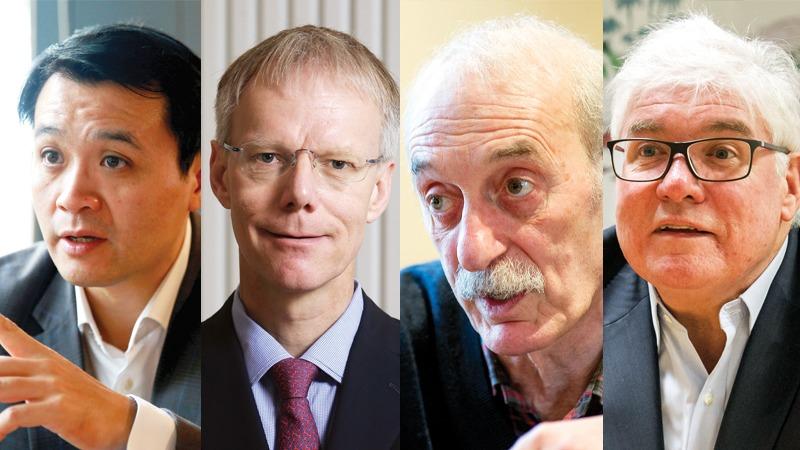 (From left) Zhu Ning, Louis Kuijs, George Magnus and Douglas McWilliams. (PHOTO PROVIDED TO CHINA DAILY)
(From left) Zhu Ning, Louis Kuijs, George Magnus and Douglas McWilliams. (PHOTO PROVIDED TO CHINA DAILY)
China has been set on a course to achieve higher-quality development and to further open up its economy, according to leading experts.
They were responding to the Government Work Report, which was delivered on March 5 by Premier Li Keqiang at the opening of the annual session of the National People’s Congress, China’s top legislature, in Beijing.
In the report, which sets out future goals as well as reviews the past year, Li set a target of “above 6 percent” for GDP growth in 2021.
He also indicated that China would not resort to the same infrastructure spending-led fiscal stimulus seen last year during the early months of the pandemic, with the fiscal deficit this year set to be cut to 3.2 percent of GDP.
With many expecting China to grow more than 8 percent this year from the low base of 2.3 percent last year, economists have welcomed the headroom that Li has given policymakers to rebalance the economy.
Stephen Roach, a US economist and senior fellow at the Jackson Institute for Global Affairs at Yale University, said the report was a move away from strict targeting and was a “welcome development”.
He said China was now committed to upgrading its economy and delivering high-quality growth.
“Barring another shock, Chinese GDP growth will easily exceed the low bar of 6 percent,” he said.
Yue Su, principal economist, China, at The Economist Intelligence Unit, the research and analysis arm of London-based Economist Group, agreed that actual GDP outcome is likely to easily surpass 6 percent.
“A flexible target aims to give greater room for policymaking. It will enable the authorities to concentrate on promoting reform and innovation,” she said.
Jeremy Stevens, chief China economist at Standard Bank, Africa’s largest bank, said China’s remarkable recovery from the pandemic — it was the only major economy to grow at all last year — was reflected in the upbeat nature of the report. He believes the economy could potentially grow 8 percent this year.
“The tone was rightly confident, given the manner in which COVID-19 has been managed, and set the scene for the economic recovery,” he said.
Stevens also welcomed the tightening of fiscal and monetary policy, which he said should put the country back on the reform trajectory it was on before the pandemic struck.
Observers were looking for more details about the new “dual circulation” economic development model, in which the domestic market is the mainstay and the domestic and international markets reinforce each other.
The new paradigm is the centerpiece of the 14th Five-Year Plan (2021-25) and is set to be ratified at the meeting.
Under this model, the domestic consumer will play a bigger role in driving the economy.
Wang Huiyao, president and founder of the Center for China and Globalization, a Beijing-based think tank, said there were a number of indicators to this in the report.
“The fact that growth will be strong will drive consumption in itself. China now has 400 million middle-class consumers and all extreme poverty has been alleviated. Reviving rural areas will also potentially have a big impact on consumption at the county level,” he said.
The report said consumer price index inflation would be around 3 percent in 2021, and 11 million new urban jobs would be created, maintaining urban unemployment at 5.5 percent.
It also committed China to spending an additional 7 percent each year in the next five years on research and development. China spent 2.44 trillion yuan (US$375.6 billion), or 2.4 percent of GDP, on R&D in 2020, according to official figures.
Zhu Ning, a professor of finance at the Shanghai Advanced Institute of Finance, said this was an important part of upgrading its economy.
“China is also looking to become more self-reliant in technology so it is less vulnerable to attempts to threaten its supply chains,” he said.
Premier Li said in the report that the government plans to bring down energy consumption by 13.5 percent and carbon dioxide emissions by 18.5 percent, both by unit of GDP, over the next five years. This is in line with the plan for carbon emissions to peak in 2030 and for the country to become carbon neutral by 2060.
Louis Kuijs, head of Asia at Oxford Economics, an economics research consultancy, said this was an important announcement.
“The report is committing to solid steps toward achieving these objectives,” he said.
Li also made clear in the report that China is looking to join the Comprehensive and Progressive Agreement for Trans-Pacific Partnership.
China joined the Regional Economic Cooperation Partnership, the other major Asian trade grouping, in November.
George Magnus, research associate at the Oxford University China Centre and a leading expert on China’s economy, believes the report attempts to maintain the current economic recovery without taking too many financial risks.
“It fits the script of taking stock after a testing and turbulent year, and the task for 2021 is to now pay down on the new five-year plan,” he said.
Douglas McWilliams, executive deputy chairman and founder of the Centre for Economics and Business Research, a London-based economics consultancy, believes the report confirms that China has been the best-performing major economy in a tumultuous year.
“At a time when world GDP shrank by nearly 4 percent, the numbers in the report are impressive,” he said.


